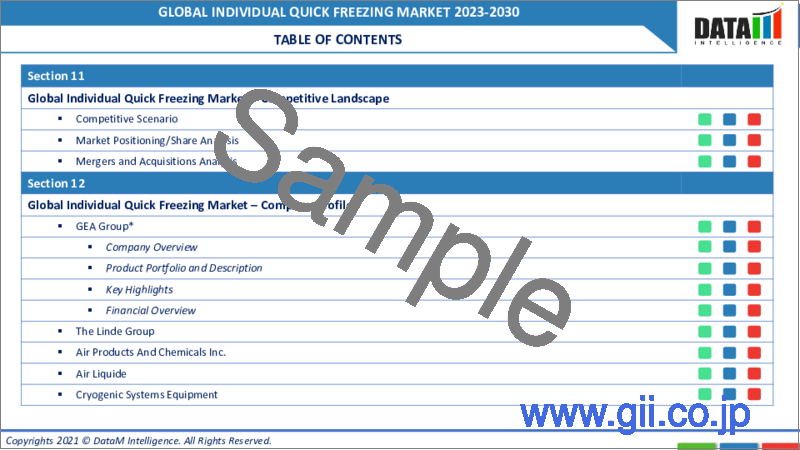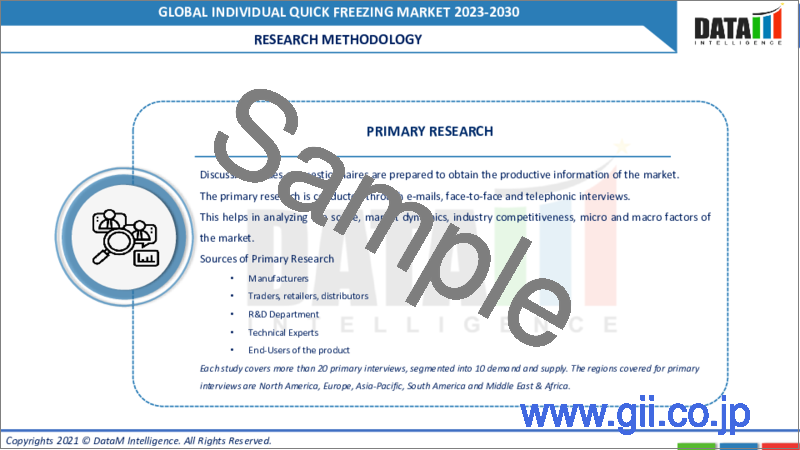|
|
市場調査レポート
商品コード
1279695
IQF(個別急速冷凍)の世界市場-2023-2030Global Individual Quick-Freezing Market - 2023-2030 |
||||||
カスタマイズ可能
適宜更新あり
|
|||||||
| IQF(個別急速冷凍)の世界市場-2023-2030 |
|
出版日: 2023年05月26日
発行: DataM Intelligence
ページ情報: 英文 200 Pages
納期: 即日から翌営業日
|
- 全表示
- 概要
- 目次
市場概要
IQF(個別急速冷凍)の世界市場規模は2022年に201億5,630万米ドルに達し、2030年には最大311億6,890万米ドルに達することで有利な成長が予測されます。予測期間2023-2030年のCAGRは5.6%で成長中です。
IQF(個別急速冷凍)は、食品の品質、風味、食感をよりよく保存することができ、また、保存や輸送をより簡単かつ効率的に行うことができます。IQF(個別急速冷凍)市場は、便利な食品への需要の増加、消費者のライフスタイルの変化、冷凍食品産業の成長によって牽引されています。
また、この市場では、高度なセンサーの使用や自動化などの技術的進歩が、IQFプロセスの効率と精度の向上に寄与しています。全体として、IQF(個別急速冷凍)業界は、食品の品質向上、保存期間の延長、廃棄物の削減など、食品業界に多くのメリットを提供しています。
市場力学
世界のRTEミール需要の高まりがIQF(個別急速冷凍)市場の成長を促進する
調理済み食品は、その利便性、保存期間の長さ、そして手軽で簡単な食事を求める時間のない消費者の増加傾向から、ますます人気が高まっています。例えば、Statistaによると、英国では2021年に調理済み料理や食事の売上が37億6,000万英ポンド以上にまで上昇するとされています。
IQF技術により、食品メーカーはすぐに食べられる食事を素早く凍らせることができ、各食材を確実に個別に凍らせることができます。したがって、すぐに食べられる食事への需要の高まりが、IQF市場の成長を後押ししています。
生鮮食品の保存需要の高まりがIQF(個別急速冷凍)市場の成長促進要因に
消費者が新鮮で健康的な食品を求めるようになり、食品の保存と保管の効果的な方法の必要性がますます高まっています。IQF(個別急速冷凍)は、生鮮食品の品質と鮮度を維持するための効果的な方法です。
超低温で食品を急速冷凍することで、IQF技術は製品の賞味期限を延ばすことができます。また、IQF技術は生鮮食品の栄養価を保つことができるため、健康志向の高い消費者にとって魅力的な選択肢となります。したがって、生鮮食品の保存に対する需要の高まりが、IQF(個別急速冷凍)市場の成長を後押ししています。
COVID-19の影響
COVID-19のパンデミックは、消費者行動の大きな変化とサプライチェーンの混乱を招き、IQF市場に影響を与えました。パンデミックは、消費者が腐らないものを買いだめしたため、IQF製品を含む冷凍食品の需要増につながっています。
しかし、COVID-19のパンデミックは世界中のサプライチェーンを混乱させ、原材料や完成品の遅延や不足を招きました。このため、メーカーは原材料の調達や需要への対応に苦慮し、IQF市場に影響を及ぼしています。
ロシア・ウクライナ紛争による影響
紛争により、ロシアとウクライナの間、およびこれらの国と貿易相手国との間の貿易に混乱が生じました。このため、原材料、設備、IQF製品を含む完成品の供給に影響が出ています。
紛争は、IQF製品の生産に使用される農産物を含む商品価格の変動を増大させることにつながりました。価格の変動は、IQFメーカーの収益性に影響を与え、消費者に提供するIQF製品の価格に影響を与える可能性があります。
目次
第1章 調査手法とスコープ
- 調査手法
- 調査目的および調査範囲
第2章 定義と概要
第3章 エグゼクティブサマリー
- 装置タイプ別
- 処理段階別
- 製品別
- 技術別
- 地域別
第4章 市場力学
- 影響要因
- 促進要因
- 調理済み食品に対する需要の高まり
- 生鮮食品の保存に対する需要の高まり
- 抑制要因
- 温室効果ガス排出に関する環境への懸念
- 機会
- フードサービス産業の拡大
- 影響分析
- 促進要因
第5章 産業分析
- ポーターのファイブフォース分析
- サプライチェーン分析
- 価格分析
- 法規制の分析
第6章 COVID-19の分析
- COVID-19の分析
- COVID-19の登場前のシナリオ
- 現在COVID-19のシナリオ
- COVID-19後のシナリオ、または将来のシナリオ
- COVID-19の中での価格・ダイナミクス
- 需給スペクトル
- パンデミック時の市場に関連する政府の取り組み
- メーカー各社の戦略的取り組み
- サマリー
第7章 機器タイプ別
- スパイラルフリーザー
- トンネルフリーザー
- ボックスフリーザー
- その他
第8章 加工段階別
- 前処理
- 凍結
- 包装
第9章 製品別
- 果物・野菜
- 魚介類
- 肉類・家禽類
- 乳製品
- コンビニエンスフーズ
- その他
第10章 技術別
- メカニカルIQF
- クライオジェニックIQF
第11章 地域別
- 北米
- 米国
- カナダ
- メキシコ
- 欧州
- ドイツ
- 英国
- フランス
- イタリア
- スペイン
- その他欧州
- 南米
- ブラジル
- アルゼンチン
- その他南米地域
- アジア太平洋地域
- 中国
- インド
- 日本
- オーストラリア
- その他アジア太平洋地域
- 中東・アフリカ地域
第12章 競合情勢
- 競合シナリオ
- 市況/シェア分析
- M&A(合併・買収)分析
第13章 企業プロファイル
- Air Liquide SA
- 会社概要
- 製品ポートフォリオと説明
- 財務概要
- 主な発展状況
- The Messer Group GmbH
- Linde Plc
- Starfrost Inc
- Octofrost Inc
- Air Products and Chemicals
- Scanico A/S
- Cryogenic System Equipment
- Marel
- GEA Group AG
第14章 付録
Market Overview
The Global Individual Quick-freezing Market size reached US$ 20,156.3 million in 2022 and is projected to witness lucrative growth by reaching up to US$ 31,168.9 million by 2030. The market is growing at a CAGR of 5.6% during the forecast period 2023-2030.
The individual quick freezing process allows for better preservation of the food's quality, flavor, and texture and also allows for easier and more efficient storage and transportation. The individual quick freezing market is driven by increasing demand for convenience foods, changing consumer lifestyles and the growth of the frozen food industry.
The market is also experiencing technological advancements, such as the use of advanced sensors and automation, which are helping to improve the efficiency and accuracy of the IQF process. Overall, the individual quick freezing industry offers numerous benefits to the food industry, including improved food quality, increased shelf life and reduced waste.
Market Dynamics
Rising Demand for Ready-to-eat Meals Worldwide is Driving the Growth of the Individual Quick-freezing Market
Ready-to-eat meals are becoming increasingly popular due to their convenience, longer shelf life, and the growing trend of time-poor consumers who are looking for quick and easy meal solutions. For instance, as per Statista, in the UK the sales of prepared dishes and meals climbed to over 3.76 billion British pounds in 2021.
IQF technology allows food manufacturers to freeze ready-to-eat meals quickly and individually, ensuring that each piece of food is frozen separately. Hence, the growing demand for ready-to-eat meals is driving the growth of IQF market growth.
The Growing Demand for Storage of Perishable Food is a Key Driver of Growth in the Individual Quick-freezing (IQF) Market
As consumers seek out fresh and healthy food options, the need for effective methods of food preservation and storage becomes increasingly important. Individual quick freezing is an effective method of preserving the quality and freshness of perishable food products.
By rapidly freezing food items at very low temperatures, IQF technology can extend the shelf life of products. IQF technology can help preserve the nutritional content of perishable foods, making them an attractive option for health-conscious consumers. Hence, the growing demand for storage of perishable food is driving the individual quick freezing market growth.
COVID-19 Impact
The COVID-19 pandemic has resulted in significant changes in consumer behavior and supply chain disruptions, which have affected the IQF market. The pandemic has led to an increase in demand for frozen food products, including IQF products, as consumers have stocked up on non-perishable items.
However, the COVID-19 pandemic has disrupted supply chains around the world, leading to delays and shortages in raw materials and finished products. This has impacted the IQF market, as manufacturers have struggled to source ingredients and meet demand.
Russia-Ukaraine Impact
The conflict has led to disruptions in trade between Russia and Ukraine, as well as between these countries and their trading partners. This has affected the supply of raw materials, equipment, and finished goods, including IQF products.
The conflict has led to increased volatility in commodity prices, including those of agricultural commodities used in the production of IQF products. Price fluctuations can affect the profitability of IQF manufacturers and impact the prices of IQF products for consumers.
Segment Analysis
The global individual quick-freezing market is segmented based on equipment type, processing stage, product, technology, and region.
Increasing Popularity of Fruits and Vegetables Due to Perishability and Convenience
Based on product, the individual quick-freezing market is classified into fruits & vegetables, seafood, meat & poultry, dairy products, convenience foods and others.
In 2022, fruits & vegetables held the highest share in the individual quick-freezing market. The demand for frozen fruits and vegetables has been increasing due to the rise in health awareness and the need for convenient food options.
For instance, according to Statista, The amount of frozen fruit consumed per person increased from 3.4 pounds in 2000 to nearly 6 pounds in 2021. IQF process allows for a wider variety of fruits and vegetables to be frozen, as they can be individually quickly frozen and packaged separately. This allows for a more diverse range of products to be offered in the market.
Geographical Analysis
Increasing Demand for Frozen Fruits in Europe
Europe has a significant share in the individual quick freezing (IQF) market, both in terms of production and consumption. Europe has a strong and diversified agricultural sector that produces a wide variety of fruits, vegetables and other perishable food products that are suitable for IQF processing.
According to CBI, in 2021, imports of frozen fruit and vegetables into Europe amounted to 4.3 million tonnes and €5.3 billion. Hence, Europe's strong agricultural sector, advanced processing technology, established market and export-oriented approach have enabled the development of a robust IQF industry in the region.
Competitive Landscape
The major global players in the market include: Air Liquide SA, The Messer Group GmbH, Linde Plc, Starfrost Inc, Octofrost Inc, Air Products and Chemicals, Scanico A/S, Cryogenic System Equipment, Marel, GEA Group AG.
Why Purchase the Report?
- To visualize the global individual quick-freezing market segmentation based on equipment type, processing stage, product and technology, as well as understand key commercial assets and players.
- Identify commercial opportunities by analyzing trends and co-development.
- Excel data sheet with numerous data points of individual quick-freezing market-level with all segments.
- PDF report consists of a comprehensive analysis after exhaustive qualitative interviews and an in-depth study.
- Product mapping available as Excel consisting of key products of all the major players.
The Global Individual Quick-freezing Market Report Would Provide Approximately 69 Tables, 70 Figures and 200 Pages.
Target Audience 2023
- Manufacturers / Buyers
- Industry Investors/Investment Bankers
- Research Professionals
- Emerging Companies
Table of Contents
1. Methodology and Scope
- 1.1. Research Methodology
- 1.2. Research Objectives and Scope of the Report
2. Definition and Overview
3. Executive Summary
- 3.1. Snippet by Equipment Type
- 3.2. Snippet by Processing Stage
- 3.3. Snippet by Product
- 3.4. Snippet by Technology
- 3.5. Snippet by Region
4. Dynamics
- 4.1. Impacting Factors
- 4.1.1. Drivers
- 4.1.1.1. Rising demand for ready-to-eat meals
- 4.1.1.2. growing demand for storage of perishable food
- 4.1.2. Restraints
- 4.1.2.1. Environmental Concerns about greenhouse gas emissions
- 4.1.3. Opportunity
- 4.1.3.1. Expansion of the food service industry
- 4.1.4. Impact Analysis
- 4.1.1. Drivers
5. Industry Analysis
- 5.1. Porter's Five Force Analysis
- 5.2. Supply Chain Analysis
- 5.3. Pricing Analysis
- 5.4. Regulatory Analysis
6. COVID-19 Analysis
- 6.1. Analysis of COVID-19
- 6.1.1. Scenario Before COVID-19
- 6.1.2. Scenario Present COVID-19
- 6.1.3. Post COVID-19 or Future Scenario
- 6.2. Pricing Dynamics Amid COVID-19
- 6.3. Demand-Supply Spectrum
- 6.4. Government Initiatives Related to the Market During the Pandemic
- 6.5. Manufacturers' Strategic Initiatives
- 6.6. Conclusion
7. By Equipment Type
- 7.1. Introduction
- 7.1.1. Market Size Analysis and Y-o-Y Growth Analysis (%), By Equipment Type
- 7.1.2. Market Attractiveness Index, By Equipment Type
- 7.2. Spiral Freezer*
- 7.2.1. Introduction
- 7.2.2. Market Size Analysis and Y-o-Y Growth Analysis (%)
- 7.3. Tunnel Freezer
- 7.4. Box Freezer
- 7.5. Others
8. By Processing Stage
- 8.1. Introduction
- 8.1.1. Market Size Analysis and Y-o-Y Growth Analysis (%), By Processing Stage
- 8.1.2. Market Attractiveness Index, By Processing Stage
- 8.2. Pre-Processing*
- 8.2.1. Introduction
- 8.2.2. Market Size Analysis and Y-o-Y Growth Analysis (%)
- 8.3. Freezing
- 8.4. Packaging
9. By Product
- 9.1. Introduction
- 9.1.1. Market Size Analysis and Y-o-Y Growth Analysis (%), By Product
- 9.1.2. Market Attractiveness Index, By Product
- 9.2. Fruits & Vegetables*
- 9.2.1. Introduction
- 9.2.2. Market Size Analysis and Y-o-Y Growth Analysis (%)
- 9.3. Seafood
- 9.4. Meat & Poultry
- 9.5. Dairy Products
- 9.6. Convenience Foods
- 9.7. Others
10. By Technology
- 10.1. Introduction
- 10.1.1. Market Size Analysis and Y-o-Y Growth Analysis (%), By Technology
- 10.1.2. Market Attractiveness Index, By Technology
- 10.2. Mechanical IQF*
- 10.2.1. Introduction
- 10.2.2. Market Size Analysis and Y-o-Y Growth Analysis (%)
- 10.3. Cryogenic IQF
11. By Region
- 11.1. Introduction
- 11.1.1. Market Size Analysis and Y-o-Y Growth Analysis (%), By Region
- 11.1.2. Market Attractiveness Index, By Region
- 11.2. North America
- 11.2.1. Introduction
- 11.2.2. Key Region-Specific Dynamics
- 11.2.3. Market Size Analysis and Y-o-Y Growth Analysis (%), By Equipment Type
- 11.2.4. Market Size Analysis and Y-o-Y Growth Analysis (%), By Processing Stage
- 11.2.5. Market Size Analysis and Y-o-Y Growth Analysis (%), By Product
- 11.2.6. Market Size Analysis and Y-o-Y Growth Analysis (%), By Technology
- 11.2.7. Market Size Analysis and Y-o-Y Growth Analysis (%), By Country
- 11.2.7.1. The U.S.
- 11.2.7.2. Canada
- 11.2.7.3. Mexico
- 11.3. Europe
- 11.3.1. Introduction
- 11.3.2. Key Region-Specific Dynamics
- 11.3.3. Market Size Analysis and Y-o-Y Growth Analysis (%), By Equipment Type
- 11.3.4. Market Size Analysis and Y-o-Y Growth Analysis (%), By Processing Stage
- 11.3.5. Market Size Analysis and Y-o-Y Growth Analysis (%), By Product
- 11.3.6. Market Size Analysis and Y-o-Y Growth Analysis (%), By Technology
- 11.3.7. Market Size Analysis and Y-o-Y Growth Analysis (%), By Country
- 11.3.7.1. Germany
- 11.3.7.2. The UK
- 11.3.7.3. France
- 11.3.7.4. Italy
- 11.3.7.5. Spain
- 11.3.7.6. Rest of Europe
- 11.4. South America
- 11.4.1. Introduction
- 11.4.2. Key Region-Specific Dynamics
- 11.4.3. Market Size Analysis and Y-o-Y Growth Analysis (%), By Equipment Type
- 11.4.4. Market Size Analysis and Y-o-Y Growth Analysis (%), By Processing Stage
- 11.4.5. Market Size Analysis and Y-o-Y Growth Analysis (%), By Product
- 11.4.6. Market Size Analysis and Y-o-Y Growth Analysis (%), By Technology
- 11.4.7. Market Size Analysis and Y-o-Y Growth Analysis (%), By Country
- 11.4.7.1. Brazil
- 11.4.7.2. Argentina
- 11.4.7.3. Rest of South America
- 11.5. Asia-Pacific
- 11.5.1. Introduction
- 11.5.2. Key Region-Specific Dynamics
- 11.5.3. Market Size Analysis and Y-o-Y Growth Analysis (%), By Equipment Type
- 11.5.4. Market Size Analysis and Y-o-Y Growth Analysis (%), By Processing Stage
- 11.5.5. Market Size Analysis and Y-o-Y Growth Analysis (%), By Product
- 11.5.6. Market Size Analysis and Y-o-Y Growth Analysis (%), By Technology
- 11.5.7. Market Size Analysis and Y-o-Y Growth Analysis (%), By Country
- 11.5.7.1. China
- 11.5.7.2. India
- 11.5.7.3. Japan
- 11.5.7.4. Australia
- 11.5.7.5. Rest of Asia-Pacific
- 11.6. Middle East and Africa
- 11.6.1. Introduction
- 11.6.2. Key Region-Specific Dynamics
- 11.6.3. Market Size Analysis and Y-o-Y Growth Analysis (%), By Equipment Type
- 11.6.4. Market Size Analysis and Y-o-Y Growth Analysis (%), By Processing Stage
- 11.6.5. Market Size Analysis and Y-o-Y Growth Analysis (%), By Product
- 11.6.6. Market Size Analysis and Y-o-Y Growth Analysis (%), By Technology
12. Competitive Landscape
- 12.1. Competitive Scenario
- 12.2. Market Positioning/Share Analysis
- 12.3. Mergers and Acquisitions Analysis
13. Company Profiles
- 13.1. Air Liquide SA*
- 13.1.1. Company Overview
- 13.1.2. Product Portfolio and Description
- 13.1.3. Financial Overview
- 13.1.4. Key Developments
- 13.2. The Messer Group GmbH
- 13.3. Linde Plc
- 13.4. Starfrost Inc
- 13.5. Octofrost Inc
- 13.6. Air Products and Chemicals
- 13.7. Scanico A/S
- 13.8. Cryogenic System Equipment
- 13.9. Marel
- 13.10. GEA Group AG
LIST NOT EXHAUSTIVE
14. Appendix
- 14.1. About Us and Services
- 14.2. Contact Us





